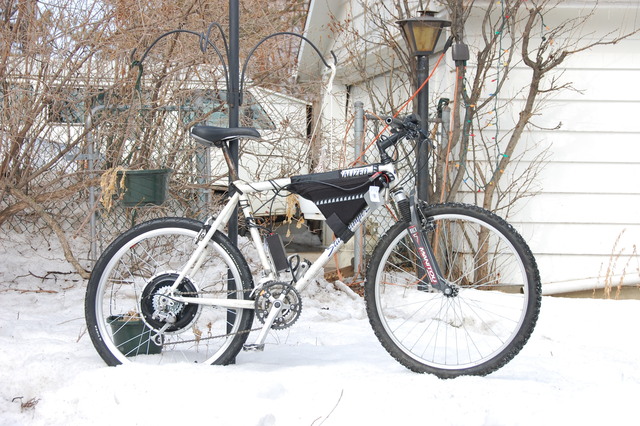I built an eBike on a pretty stiff CrMo frame, with reasonable weight distribution (rear hub motor, batteries in front triangle. See build post earlier this spring:
http://endless-sphere.com/forums/viewtopic.php?f=4&t=9549&p=147520&hilit=stumpjumper#p147520)

However handling is pretty sloppy. I realize it can't be as crisp as my roadbike or regular MTB due to the increased weight, but I'd like to improve it as much as possible. In particular when steering it feels sloppy. Doing tight curves at speed, it feels like the rear end is going to slide away like an oversteered car. When twiddling the steering left and right, it can start oscillating. Likewise riding no hands it also is prone to steering oscillations.
I'm already working on a solution to replace the cloth battery frame pack with a rigid frame mount box.
I've made sure all the bearings (headset, wheels) have no slop.
I'm wondering what other things I should focus on to improve handling?
Tightening up suspension fork? Wider rear rim? Stiffening rear wheel? Other ideas?
Original construction of the Manitou V fork looks decent. However fork struts are sloppy from wear. Not sure if I can fix that. Frame takes a 1" fork, and I don't see high quality forks in that size anymore.
Rear wheel is pretty significantly dished to be centered. I can bring it back a bit off center, and thereby maybe get a bit more even spoke tension. Would this help?
http://endless-sphere.com/forums/viewtopic.php?f=4&t=9549&p=147520&hilit=stumpjumper#p147520)
However handling is pretty sloppy. I realize it can't be as crisp as my roadbike or regular MTB due to the increased weight, but I'd like to improve it as much as possible. In particular when steering it feels sloppy. Doing tight curves at speed, it feels like the rear end is going to slide away like an oversteered car. When twiddling the steering left and right, it can start oscillating. Likewise riding no hands it also is prone to steering oscillations.
I'm already working on a solution to replace the cloth battery frame pack with a rigid frame mount box.
I've made sure all the bearings (headset, wheels) have no slop.
I'm wondering what other things I should focus on to improve handling?
Tightening up suspension fork? Wider rear rim? Stiffening rear wheel? Other ideas?
Original construction of the Manitou V fork looks decent. However fork struts are sloppy from wear. Not sure if I can fix that. Frame takes a 1" fork, and I don't see high quality forks in that size anymore.
Rear wheel is pretty significantly dished to be centered. I can bring it back a bit off center, and thereby maybe get a bit more even spoke tension. Would this help?

